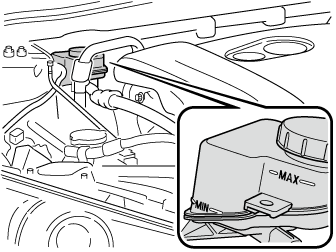Owner Maintenance Precautions
Bonnet
Engine Compartment Overview
Engine Oil
Engine Coolant
Brake/Clutch Fluid
Window Washer Fluid
Body Lubrication
Wiper Blades
Battery
Key Battery Replacement
Tyres
Light Bulbs
Fuses
Emission Control Maintenance (Australia)
Inspecting Brake/Clutch Fluid Level
If the brake/clutch fluid level is low, have the brakes inspected:
A low brake/clutch fluid level is dangerous.
A low level could indicate brake lining wear or a brake system leak which could cause the brakes to fail and lead to an accident.
Close Warning

View Warning

The brakes and clutch draw fluid from the same reservoir.
Inspect the fluid level in the reservoir regularly. It should be kept between the MAX and MIN lines.
The level normally drops with accumulated distance, a condition associated with wear of brake and clutch linings. If it is excessively low, have the brake/clutch system inspected by an expert repairer, we recommend an Authorised Mazda Repairer.



 Read this first
Read this first



















